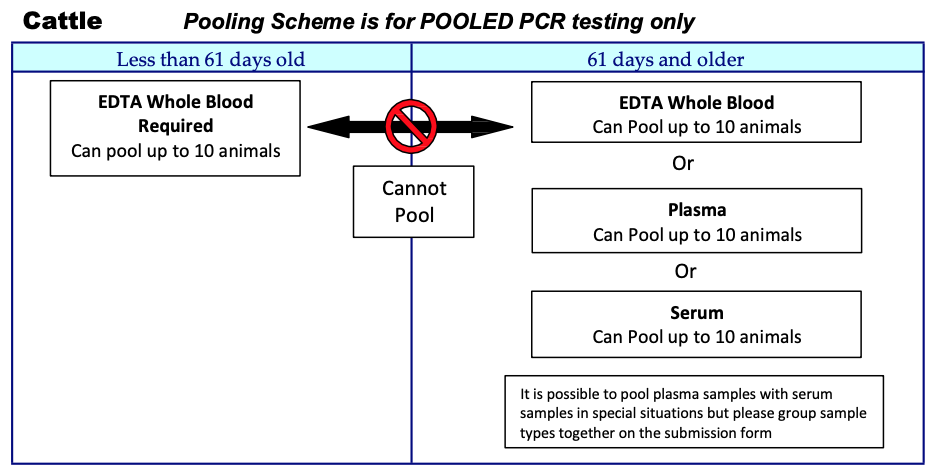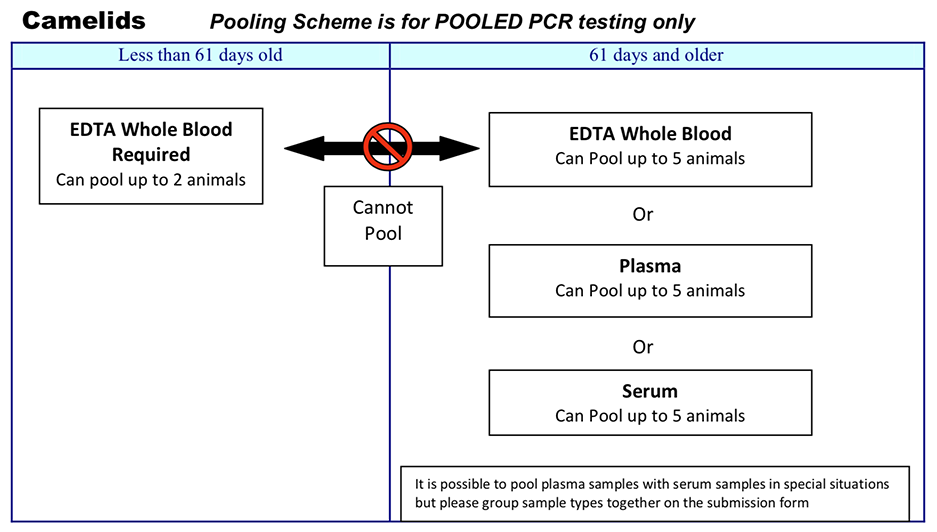Bovine Virus Diarrhea Virus (BVDV)
Testing Options for Detection of Bovine Virus Diarrhea Virus (BVDV)
Antigen Capture ELISA (ACE) on skin samples
- Any age of cattle can be tested using fresh skin (not fixed)
- Ear notch samples will not be pooled.
- Turnaround time = 2-4 days
Antigen Capture ELISA (ACE) on serum samples
- Cattle must be 61 days of age or older.
- Serum samples will not be pooled for the ACE test.
- Turnaround time = 2-4 days
*Bulk Tank Milk Testing – Virus Isolation and PCR
- BVD PCR and Virus Isolation (VI) are performed on each bulk tank milk sample. Performing both tests together increase the sensitivity for detecting BVDV.
- Minimum of 200 ml of fluid milk per sample/tank.
- Maximum of 400 cattle in one sample to avoid dilution of BVD virus. String sampling, (submitting multiple samples) is recommended for dairies milking more than 400 head.
- Sample containers need not be sterile; tap water clean plastic soda bottles are fine.
- DO NOT FREEZE; freezing milk will lyse the somatic cells and decrease the sensitivity of the detection assays (PCR and VI).
- Do not allow milk to clot and do not add preservatives.
- Samples need to arrive at the AHDC Monday-Thursday, within 24-48 hours of collection. Fermentation occurs naturally in stored milk and may interfere with the results.
- PCR turnaround time = 2 business days
Virus Isolation
- EDTA whole blood for any age but serum is acceptable for animals 61 days and older
- Turnaround time = 10-14 day
Individual PCR
- Cattle less than 61 days of age – EDTA whole blood required (ship overnight, do not freeze)
- Cattle 61 days and older – EDTA whole blood, plasma, or serum are acceptable.
- Write “Individual PCR” on the submission form.
- Turnaround time = 2 business days
Pooled PCR
- POOLED BVD PCR testing will be performed, if appropriate, on multiple blood samples (up to 10) submitted for detection of BVDV Persistently Infected (PI) animals unless the INDIVIDUAL BVD PCR test is indicated.
- Cattle less than 61 days of age – EDTA whole blood required (ship overnight, do not freeze)
- Cattle 61 days and older – EDTA whole blood, plasma, or serum are acceptable.
- Pooled testing should only be used to test otherwise apparently healthy animals for the detection of Persistently Infected (PI) animals.
- Submit individually labeled samples; pooling is performed at the AHDC lab. Samples submitted as composite/pooled will be rejected.
- Animals less than 61 days of age will not be pooled with animals 61 days and older.
- See diagram below for pooling scheme; turnaround time = 3-5 days
- Samples from different owners will not be pooled.
- In the event of a positive pool on animals at least 61 days of age, BVDACE testing will be done on individual samples to identify the PI animal(s) at an additional cost, refer to test and fee for current cost. For positive pools of animals under 61 days of age, BVDPCR testing will be done on individual samples at an additional cost.

Camelids
Virus Isolation
- EDTA whole blood for any age but serum is acceptable for animals 61 days and older
- Turnaround time = 10-14 days
Individual PCR
- Camelids less than 61 days of age – EDTA whole blood required (ship overnight, do not freeze)
- Camelids 61 days and older – EDTA whole blood, plasma, or serum are acceptable.
- Write "Individual PCR" on the submission form.
- Turnaround time = 2 business days
Pooled PCR
- POOLED BVD PCR testing will be performed, if appropriate, on multiple blood samples submitted for detection of BVDV Persistently Infected (PI) animals unless the INDIVIDUAL BVD PCR test is indicated.
- Camelids less than 61 days of age – EDTA whole blood required (ship overnight, do not freeze)
- Camelids 61 days and older – EDTA whole blood, plasma, or serum are acceptable.
- Submit individually labeled samples; pooling is performed at the lab (up to 2 for camelids <61 days old; up to 5 for camelids >61 days old). Samples submitted as composite/pooled will be rejected.
- Animals less than 61 days of age will not be pooled with animals 61 days and older.
- See diagram below for pooling scheme; lag time = 2 business days
- Samples from different owners will not be pooled
- In the event of a positive pool, BVDPCR testing will be done on individual samples at an additional cost.

*Additional Information on Bulk Milk Testing
A BVD positive bulk tank indicates:
-
Acutely infected cattle with circulating BVD
OR -
One or more persistently infected cattle
OR - Both acute infection and PI animals
The bulk tank sample is centrifuged, and a pellet of somatic cells is collected and used for testing. Simply testing the fluid milk by PCR is not adequate, as we have detected samples that were PCR and virus isolation positive on the somatic cells, but PCR negative on the fluid milk sample. The BVD PCR result is reported in 2 business days, but the virus isolation results are reported in 7-10 days because the virus has to grow (or not grow) in cell culture.
An accurate list of all animals represented in the bulk tank or string samples should be generated at the time of sampling, any pen changes tracked, and all of the animals that leave the milking herd, including deaths, following the collection of the milk sample(s) should be individually sampled. (Appropriate samples from individual cows include ear notch [OK to ear notch carcass], EDTA whole blood, or serum for BVD Antigen Capture ELISA to detect PIs). This is to guard against the possibility that a persistently infected (PI) animal is culled before testing the entire lactating group as indicated by a positive bulk tank test. The failure to find a PI animal under that circumstance would appear to represent a false positive test result when in fact the positive animal was culled before the herd test. A positive test result is significant, but negative results must be interpreted with caution, particularly without information regarding the PI status of non-lactating animals in the herd. Testing for BVDV in the individual animal in the absence of hard evidence for its presence in the herd is expensive and may discourage future testing when a valid reason does exist. Bulk tank testing is one method to generate the needed evidence.
Information on the development of the BVD bulk tank testing at the AHDC:
Testing of milk from the bulk tank has been an accepted practice for many years, particularly concerning the detection of bacteria and mycoplasma. In 1995, Radwan, Brock, Hogan, and Smith at the Ohio Agricultural Research and Development Center published a report (Vet Microbiol 44:77-92) indicating that bulk milk samples may be a useful sample for detecting BVDV persistently infected animals in the lactating herd using PCR. Of the 136 herds that they tested, 33 were PCR positive, but none were found positive by their virus isolation procedure using the somatic cells as the test sample.
At the Animal Health Diagnostic Center, we were interested in this report, but we approached implementing this test with caution. We began limited testing using PCR, but we also did parallel testing by virus isolation. We were able to detect BVDV in somatic cells from the bulk milk sample by PCR, but we were also able to detect the virus by our standard virus isolation procedures (culturing viable "somatic" cells).
In >95% of the cases, we had agreement between PCR results and the virus isolation tests. This finding is in sharp contrast to Radwan et al. where all PCR-positive samples were virus isolation negative. We continue to use both tests on the somatic cells from the bulk tank because we recognize that no test works in all situations. Also, milk from acutely infected cattle in the bulk tank sample may cause either a PCR-positive result or growth in virus isolation; we do not have research data on bulk tank samples to compare acutely infected cattle with PIs. This discrepancy between the two tests may be due to residual non-infectious viral nucleic acid (PCR detectable) at the end of an acute infection.
Modified live vaccine administration to the herd or a subset of animals in the herd can result in BVD PCR-positive results. Viral isolation of the vaccine strain of BVD is also possible.


